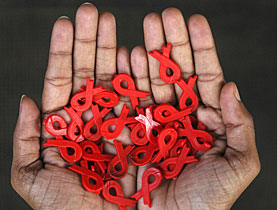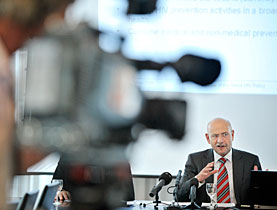“Courier me over some condoms”

Dilemma! You are both in the mood, but you’ve run out. Don’t risk it, call “Dial-a-rubber” and a bike courier will zip round with a pack of three.
No, this is not a gag, but rather the latest Swiss Aids/HIV awareness initiative. The summer campaign is taking place as Swiss specialists prepare for the biennial International Aids Conference in Vienna, Austria, which opened on Sunday.
“We transport anything, anywhere” – Velokurier cycle couriers in Bern are certainly living up to their reputation.
From the middle of June until the end of August, the courier company, along with Velopostale in Geneva and Veloblitz in Zurich, is offering a very personal service – a pack of three condoms biked directly to your door for SFr8 ($7).
“It’s kind of a joke with a serious background,” Velokurier’s Reto Baumann told swissinfo.ch.
So far there have not been many takers, but this could be because “we deliver during office hours and the most popular times are at night and the weekend”, he added.
Whatever the final sales figures may be, Bettina Maeschli, spokeswoman for the Swiss Aids Federation, is convinced the message is an effective one.
“It’s been a success as we’ve had lots of media coverage and people are talking about the campaign,” she explained. “We’re trying to remind people to think about condoms in situations even when they may not be prepared.”
Switzerland’s Love Life Stop Aids preventive campaign, led by the Federal Health Office and the Swiss Aids Federation, has been running for several years now.
Downward trend
Initiatives in saunas, bars and specialist magazines, targeting gay and bisexual men, have been particularly successful over the past two years, the federation spokeswoman said.
This year the rate of new infections of HIV, the virus that causes Aids, among homosexual men dropped significantly for the first time since 2001, according to the Federal Health Office.
Figures released in May 2010 showed a 17 per cent fall in the number of new cases between 2008 and 2009 to 646; and the downwards trend seems to be continuing this year, said Maeschli.
In November 2008 a United Nations report on Aids found that 50 people in Switzerland died of complications related to HIV infections. In 1995 the figure was 600.
Antiviral therapies, costing up to SFr2,100 per month, have made a huge improvement to people’s lives.
Some 70 per cent of those living with HIV in Switzerland have a job, but discrimination still exists in the workplace, among colleagues and over things like health and life insurance, said the spokeswoman.
“People with HIV can’t get life insurance and it’s a problem for someone wanting to buy a house as they can’t get a loan or mortgage,” she said.
Eastern Europe
Swiss government campaigns also focus on two other at-risk groups: people from countries with a high prevalence of HIV infection, especially sub-Saharan Africa, and injection drug users.
The good news is that new rates of infection are dropping in Switzerland among drug users who share needles. At the end of the 1980s, such users accounted for the majority of new infections. In 2008 they represented less than four per cent of new cases.
The global Aids conference which opened in Vienna on Sunday is hoping to draw attention to the worrying situation in eastern Europe and central Asia, where the number of people living with HIV increased by 66 per cent between 2001 and 2008, mainly among drug users. In Ukraine 1.6 per cent of the population are HIV positive.
Luciano Ruggia, a Swiss delegate from the Federal Health Office attending the conference, said it was in Switzerland’s interest for something to be urgently done in that part of the world.
“With the increasing mobility of populations it’s not in our interest to see an increase of the infection among this group of people,” he said ahead of the meeting.
STIs
Switzerland hopes to exchange ideas with other countries at the conference and learn more about risk groups like men who have sex with men and migrants, added Ruggia.
The Swiss Aids Federation presently has a number of community programmes with groups from sub-Saharan Africa and eastern Europe living in Switzerland to explain how the virus is transmitted and to help with issues of discrimination.
Sub-Saharan Africa remains the most heavily affected area of the planet. About 22.4 million people, or two-thirds of all HIV-positive people, live with the disease there.
Switzerland will also present its new national programme for HIV and sexually transmitted infections (STI), such as syphilis, gonorrhoea and chlamydia, which have increased greatly this year.
“Co-infection is really a big problem,” said Ruggia. “Someone with an STI is more at risk of getting HIV, and for people living with HIV, getting another STI is something that is not very good for their health.”
Simon Bradley, swissinfo.ch (with input from Isobel Leybold-Johnson)
The meeting is taking place from July 18-23 in the Austrian capital, Vienna. Its aim is to build bridges between research, the political world, business figures, NGOs and those affected.
There is a wealth of different topics, but the main focus is on Eastern Europe and central Asia, as well as issues like treatment and discrimination.
The conference will feature a glamorous Life Ball to raise funds for Aids sufferers. Among those expected are actresses Liz Hurley and Whoopi Goldberg, as well as former US president Bill Clinton and ex-tennis ace Boris Becker. There will also be a human rights march with singer Annie Lennox and Free Hugs 4 Aids as well.
Around 25,000 participants from more than 100 countries are expected.
According to UNAIDS, around 60 million people worldwide have become infected with HIV, the virus which causes Aids, since the illness first came to light almost 30 years ago. Around 25 million have died.
In 2008 33.4 million people were HIV positive, and around 2 million died from Aids. Most infections take place at age 20-50. 2.1 million children under 15 live with the virus.
The most affected area is sub-Saharan Africa, followed by south and southeastern Asia and Latin America.
The Swiss Federal Health Office says that there are an estimated 20,000-30,000 people living with HIV in the country, of which around a quarter are unaware of the infection. Since the first statistics were kept in 1983, 6,982 people have died of Aids (March 2010 figures).
In 2009 642 people tested positive for HIV, 179 developed Aids.
The number of young people infected with HIV in Africa is falling in 16 of the 25 countries hardest hit by the virus, according to a new report by UNAIDS.
The number of young people infected with HIV dropped by at least 25% in a dozen countries, the UNAIDS report said. In Kenya, the infection rate among people aged 15 to 24 fell from about 14% in 2000 to 5.4% in urban areas.
The drop in HIV rates coincided with a change in sexual , like having fewer sexual partners or increased condom use, it said. But the agency could not say the drop was because of recent UN policies, which have mainly focused on buying Aids drugs rather than preventing infections.


In compliance with the JTI standards
More: SWI swissinfo.ch certified by the Journalism Trust Initiative













You can find an overview of ongoing debates with our journalists here . Please join us!
If you want to start a conversation about a topic raised in this article or want to report factual errors, email us at english@swissinfo.ch.